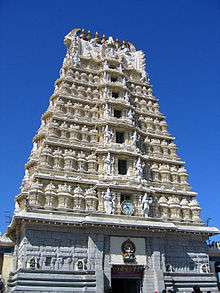Chamunda
Chamunda (Sanskrit: चामुण्डा, IAST: Cāmuṇḍā) also known as Chamundeshwari, Chamundi, and Raktandika is a fearsome form of Chandi, the Hindu Divine Mother Parvati and is one of the seven Matrikas (mother goddesses).[2]
| Chamunda | |
|---|---|
Goddess of war and "epidemics of pestilent diseases, famines, and other disasters".[1] | |
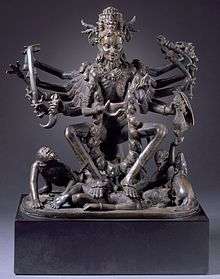 Leader of the Matrikas | |
| Devanagari | चामुण्डा |
| Affiliation | Parvati, Kali, Mahakali, Shakti |
| Abode | Cremation grounds or fig trees |
| Mantra | Om aim hreem Kleem Chamundaye Vichche |
| Weapon | Trident and Sword |
| Mount | Corpse (Preta) |
| Consort | Shiva as Bheeshan Bhairava |
| Part of a series on |
| Shaktism |
|---|
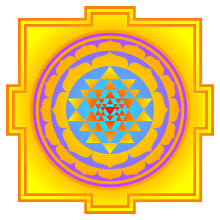 |
|
Schools |
|
Festivals and temples |
|
|
She is also one of the chief Yoginis, a group of sixty-four or eighty-one Tantric goddesses, who are attendants of the warrior goddess parvati.[3] The name is a combination of Chanda and Munda, two monsters whom Chamunda killed. She is closely associated with Kali, another fierce aspect of Parvati. She is identified with goddesses Parvati, Kali or Durga.
The goddess is often portrayed as haunting cremation grounds or fig trees. The goddess is worshipped by ritual animal sacrifices along with offerings of wine and in the ancient times, human sacrifices were offered too. The practice of animal sacrifices has become less common with Shaivite and Vaishnavite influences.
Origins
Ramakrishna Gopal Bhandarkar says that Chamunda was originally a tribal goddess, worshipped by the tribals of the Vindhya mountains in central India. These tribes were known to offer goddesses animal as well as human sacrifices along with ritual offerings of liquor. These methods of worship were retained in Tantric worship of Chamunda, after assimilation in Hinduism. He proposes the fierce nature of this goddess is due of her association with Vedic Rudra (identified as Shiva in modern Hinduism), identified with fire god Agni at times.[4] Wangu also backs the theory of the tribal origins of the goddess. Apart from her popular names like Chamunda, Chamundi, Chamundeshwari, Charchika and Rakta Kali she is also known as Rudira Kali, Chanda Kali, Rudira, Rudira Mala devi, Rudiramma, Rudireshwari, Rakteshwari, Rakta Chamundi, Vir Kali, Porkali, Ghalurika, Ugra Chandi, Kalari Devi and Ati bhaya Kali regionally in India and Nepal. She is popularly worshipped as the goddess of war and patron of martial arts like Kalaripayattu.[5]
Iconography
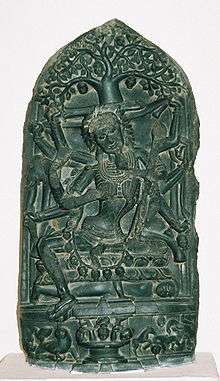
The black or red coloured Chamunda is described as wearing a garland of severed heads or skulls (Mundamala). She is described as having four, eight, ten or twelve arms, holding a Damaru (drum), trishula (trident), sword, a snake, skull-mace (khatvanga), thunderbolt, a severed head and panapatra (drinking vessel, wine cup) or skull-cup (kapala), filled with blood. Standing on a corpse of a man (shava or preta) or seated on a defeated demon or corpse (pretasana). Chamunda is depicted adorned by ornaments of bones, skulls, and serpents. She also wears a Yajnopavita (a sacred thread worn by mostly Hindu priests) of skulls. She wears a jata mukuta, that is, headdress formed of piled, matted hair tied with snakes or skull ornaments. Sometimes, a crescent moon is seen on her head.[6][7] Her eye sockets are described as burning the world with flames. She is accompanied by evil spirits.[7][8] She is also shown to be surrounded by skeletons or ghosts and beasts like jackals, who are shown eating the flesh of the corpse which the goddess sits or stands on. The jackals and her fearsome companions are sometimes depicted as drinking blood from the skull-cup or blood dripping from the severed head, implying that Chamunda drinks the blood of the defeated enemies.[9] This quality of drinking blood is a usual characteristic of all Matrikas, and Chamunda in particular. At times, she is depicted seated on an owl, her vahana (mount or vehicle). Her banner figures an eagle.[7]
These characteristics, a contrast to usual Hindu goddess depiction with full breasts and a beautiful face, are symbols of old age, death, decay and destruction.[10] Chamunda is often said as a form of Kali, representing old age and death. She appears as a frightening old woman, projecting fear and horror.[11][12]
Hindu legends

In Hindu scripture Devi Mahatmya, Chamunda emerged as Chandika Jayasundara from an eyebrow of goddess Kaushiki, a goddess created from "sheath" of Durga and was assigned the task of eliminating the demons Chanda and Munda, generals of demon kings Shumbha-Nishumbha. She fought a fierce battle with the demons, ultimately killing them.[13]
According to a later episode of the Devi Mahatmya, Durga created Matrikas from herself and with their help slaughtered the demon army of Shumbha-Nisumha. In this version, Kali is described as a Matrika who sucked all the blood of the demon Raktabija, from whose blood drop rose another demon. Kali is given the epithet Chamunda in the text.[14] Thus, the Devi Mahatmya identifies Chamunda with Kali.[15]
In the Varaha Purana, the story of Raktabija is retold, but here each of Matrikas appears from the body of another Matrika. Chamunda appears from the foot of the lion-headed goddess Narasimhi. Here, Chamunda is considered a representation of the vice of tale-telling (pasunya). The Varaha Purana text clearly mentions two separate goddesses Chamunda and Kali, unlike Devi Mahatmya.[7]
According to another legend, Chamunda appeared from the frown of the benign goddess Parvati to kill demons Chanda and Munda. Here, Chamunda is viewed as a form of Parvati.[16]
The Matsya Purana tells a different story of Chamunda's origins. She with other matrikas was created by Shiva to help him kill the demon Andhakasura, who has an ability - like Raktabija - to generate from his dripping blood. Chamunda with the other matrikas drinks the blood of the demon ultimately helping Shiva kill him.[7] Ratnakara, in his text Haravijaya, also describes this feat of Chamunda, but solely credits Chamunda, not the other matrikas of sipping the blood of Andhaka. Having drunk the blood, Chamunda's complexion changed to blood-red.[17] The text further says that Chamunda does a dance of destruction, playing a musical instrument whose shaft is Mount Meru, the spring is the cosmic snake Shesha and gourd is the crescent moon. She plays the instrument during the deluge that drowns the world.[8]
Association with Matrikas
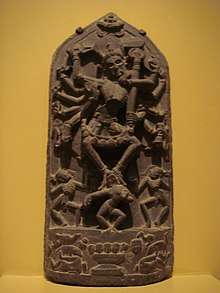
Chamunda is one of the saptamatrikas or Seven Mothers. The Matrikas are fearsome mother goddesses, abductors and eaters of children; that is, they were emblematic of childhood pestilence, fever, starvation, and disease. They were propitiated in order to avoid those ills, that carried off so many children before they reached adulthood.[11] Chamunda is included in the Saptamatrika (seven Matrikas or mothers) lists in the Hindu texts like the Mahabharata (Chapter 'Vana-parva'), the Devi Purana and the Vishnudharmottara Purana. She is often depicted in the Saptamatrika group in sculptures, examples of which are Ellora and Elephanta caves. Though she is always portrayed last (rightmost) in the group, she is sometimes referred to as the leader of the group.[18] While other Matrikas are considered as Shaktis (powers) of male divinities and resemble them in their appearance, Chamunda is the only Matrika who is a Shakti of the great Goddess Devi rather than a male god. She is also the only Matrika who enjoys independent worship of her own; all other Matrikas are always worshipped together.[19]
The Devi Purana describe a pentad of Matrikas who help Ganesha to kill demons.[20] Further, sage Mandavya is described as worshipping the Māṭrpaňcaka (the five mothers), Chamunda being one of them. The mothers are described as established by the creator god Brahma for saving king Harishchandra from calamities.[21] Apart from usual meaning of Chamunda as slayer of demons Chanda and Munda, the Devi Purana gives a different explanation: Chanda means terrible while Munda stands for Brahma's head or lord or husband.[22]
In the Vishnudharmottara Purana - where the Matrikas are compared to vices - Chamunda is considered as a manifestation of depravity.[23] Every matrika is considered guardian of a direction. Chamunda is assigned the direction of south-west.[16]
Chamunda, being a Matrika, is considered one of the chief Yoginis, who are considered to be daughters or manifestations of the Matrikas. In the context of a group of sixty-four yoginis, Chamunda is believed to have created seven other yoginis, together forming a group of eight. In the context of eighty-one yoginis, Chamunda heads a group of nine yoginis.[3]
Hindu worship
A South Indian inscription describes ritual sacrifices of sheep to Chamunda.[24] In Bhavabhuti's eighth century Sanskrit play, Malatimadhva describes a devotee of the goddess trying to sacrifice the heroine to Chamunda's temple, near a cremation ground, where the goddess temple is.[25] A stone inscription at Gangadhar, Rajasthan, deals with a construction to a shrine to Chamunda and the other Matrikas, "who are attended by Dakinis" (female demons) and rituals of daily Tantric worship (Tantrobhuta) like the ritual of Bali (offering of grain).[26]
Many Kshatriyas and even the Jain community worship her as their Kuladevi "family deity". The Chapa dynasty worshiped her as their kuladevi. The Kutch Gurjar Kshatriyas worship her as kuladevi and temples are in Sinugra and Chandiya. Alungal family, a lineage of Mukkuva caste — (Hindu caste of seafarer origin) in Kerala — worship chamundi in Chandika form, as Kuladevta and temple is in Thalikulam village of Thrissur, Kerala. This is an example of Chamunda worship across caste sects.
Temples
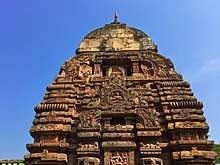

In the Kangra district of Himachal Pradesh, around 10 kilometres (6.2 mi) west of Palampur, is the renowned Chamunda Devi Temple which depicts scenes from the Devi Mahatmya, the Ramayana and the Mahabharata. The goddess's image is flanked by the images of Hanuman and Bhairava. Another temple, Chamunda Nandikeshwar Dham, also found in Kangra, is dedicated to Shiva and Chamunda. According to a legend, Chamunda was enshrined as chief deity "Rudra Chamunda", in the battle between the demon Jalandhara and Shiva.
In Gujarat, two Chamunda shrines are on the hills of Chotila and Parnera.
There are multiple Chamunda temples in Odisha. The 8th-century Baitala Deula is the most prominent of them, also being one of the earliest temples in Bhubaneswar. The Mohini temple and Chitrakarini temple in Bhubaneswar are also dedicated to Chamunda. Kichakeshwari Temple, near the Baripada and Charchika Temple, near Banki enshrine forms of Chamunda.
Another temple is Chamundeshwari Temple on Chamundi Hill, Mysore. Here, the goddess is identified with Durga, who killed the buffalo demon. Chamundeshwari or Durga, the fierce form of Shakti, a tutelary deity held in reverence for centuries by the Maharaja of Mysore.
The Chamunda Mataji temple in Mehrangarh Fort, Jodhpur, was established in 1460 after the idol of the goddess Chamunda — the Kuladevi and iṣṭa-devatā (tutelary deity) of the Parihar rulers — was moved from the old capital of Mandore by the then-ruler Jodha of Mandore. The goddess is still worshiped by the royal family of Jodhpur and other citizens of the city. The temple witnesses festivities in Dussehra: the festival of the goddess.
Another temple, Sri Chamundeshwari Kshetram is near Jogipet, in Medak District in Telangana State.[27][28]
See also
References
- Nalin, David R. (15 June 2004). "The Cover Art of the 15 June 2004 Issue". Clinical Infectious Diseases. 39 (11): 1741–1742. doi:10.1086/425924. PMID 15578390.
- Wangu p.72
- Wangu p.114
- Vaisnavism Saivism and Minor Religious Systems By Ramkrishna G. Bhandarkar, p.205, Published 1995, Asian Educational Services, ISBN 81-206-0122-X
- Wangu p.174
- See:
- Kinsley p. 147, 156. Descriptions as per Devi Mahatmya, verses 8.11-20
- "Sapta Matrikas (12th C AD)". Department of Archaeology and Museums, Government of Andhra Pradesh. Archived from the original on July 1, 2007. Retrieved 2008-01-08.
- Donaldson, T. "Chamunda, The fierce, protective eight-armed mother". British Museum.
- "Chamunda, the Horrific Destroyer of Evil [India, Madhya Pradesh] (1989.121)". In Timeline of Art History. New York: The Metropolitan Museum of Art, 2000–. http://www.metmuseum.org/toah/ho/07/ssn/ho_1989.121.htm (October 2006)
- Kalia, pp.106–109.
- Goswami, Meghali; Gupta, Ila; Jha, P. (March 2005). "Sapta Matrikas In Indian Art and their significance in Indian Sculpture and Ethos: A Critical Study" (PDF). Anistoriton Journal. Anistoriton. Retrieved 2008-01-08. "Anistoriton is an electronic Journal of History, Archaeology and ArtHistory. It publishes scholarly papers since 1997 and it is freely available on the Internet. All papers and images since vol. 1 (1997) are available on line as well as on the free Anistorion CD-ROM edition."
- Kinsley p.147
- "Durga: Avenging Goddess, Nurturing Mother ch.3, Chamunda". Norton Simon Museum. Archived from the original on 2006-10-03.
- Wangu p.94
- http://www.art-and-archaeology.com/india/jagat/jagat13.html
- http://www.art-and-archaeology.com/asianartglossary.html#chamunda
- Gopal, Madan (1990). K.S. Gautam (ed.). India through the ages. Publication Division, Ministry of Information and Broadcasting, Government of India. p. 81.
- Kinsley p. 158, Devi Mahatmya verses 10.2-5
- "Devi: The Great Goddess". www.asia.si.edu. Archived from the original on 2017-06-09. Retrieved 2017-05-29.
- Moor p.118
- Handelman pp.132–33
- Handelman p.118
- Kinsley p.241 Footnotes
- Pal in Singh p.1840, Chapters 111-116
- Pal in Singh p.1840, Chapter 116(82-86)
- Pal p.1844
- Kinsley p. 159
- Kinsley p.146
- Kinsley p.117
- Joshi, M.C. in Harper and Brown, p.48
- Babb, Lawrence A. Alchemies of Violence: Myths of Identity and the Life of Trade in Western India, Published 2004, 254 pages, ISBN 0-7619-3223-2 pp.168–9, 177-178.
- Encyclopaedia of Jainism By Narendra Singh p.698
Further reading
| Wikimedia Commons has media related to Chamunda. |
- Wangu, Madhu Bazaz (2003). Images of Indian Goddesses. Abhinav Publications. 280 pages. ISBN 81-7017-416-3.
- Pal, P. The Mother Goddesses According to the Devipurana in Singh, Nagendra Kumar, Encyclopaedia of Hinduism, Published 1997, Anmol Publications PVT. LTD.,ISBN 81-7488-168-9
- Kinsley, David (1988). Hindu Goddesses: Vision of the Divine Feminine in the Hindu Religious Traditions. University of California Press. ISBN 0-520-06339-2
- Kalia, Asha (1982). Art of Osian Temples: Socio-Economic and Religious Life in India, 8th-12th Centuries A.D. Abhinav Publications. ISBN 0-391-02558-9.
- Handelman, Don. with Berkson Carmel (1997). God Inside Out: Siva's Game of Dice, Oxford University Press US. ISBN 0-19-510844-2
- Moor, Edward (1999). The Hindu Pantheon, Asian Educational Services, ISBN 81-206-0237-4. First published: 1810.
